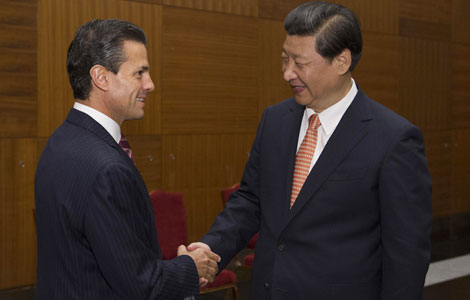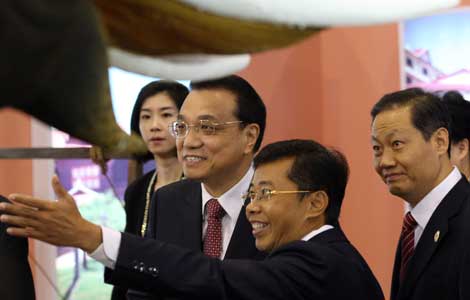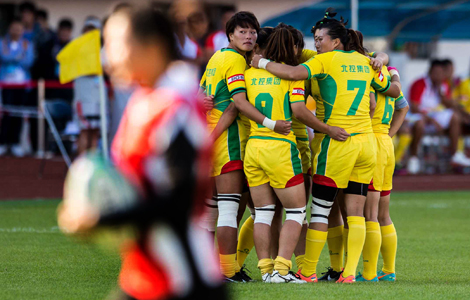Modernity looms in new weave works
Updated: 2013-09-05 07:24
By Wang Kaihao and Yang Fang in Chifeng, Inner Mongolia (China Daily)
|
||||||||
What's the top must-see sight for visitors spending only one afternoon in the downtown area of Chifeng, the most populous city in the east of the Inner Mongolia autonomous region? Several locals offer a surprisingly identical answer: a factory.
Perhaps it is more suitable to call Liwang Crafts and Arts Company an arts gallery, especially on this quiet Saturday afternoon. Numerous tapestries of various sizes hang all around the spacious workshop. The salvo of abundant colors makes it hard for viewers to focus on a single work. The images include landscapes, portraits, and mimicked famous paintings from all over the world - all so lifelike you wouldn't know they are woolen without touching them.
The loom and manufacturing process look no different than those for other traditional tapestries or carpet-making in China - except for the overwhelming scrutiny to detail.
Most blueprints are drawn on simple A4 paper, and 200-odd workers in the factory have to duplicate them into much larger woolen versions. A strand of wool used for weaving contains five to eight fibrous threads in gradually changing colors.
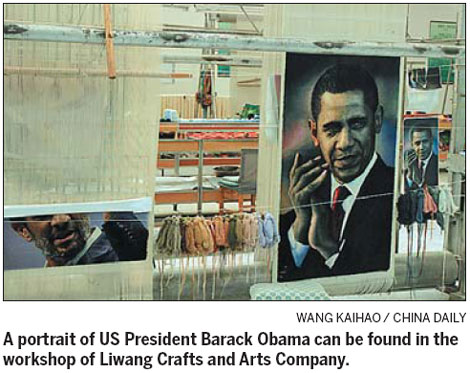
Rainbow bright
"Color is the most crucial part of these tapestries," explains Sun Lijie, the chief engineer of the factory. "It is common to use more than 600 colors weaving a portrait. Sometimes it takes more than 200 to make one face vivid."
A piece portraying Mu Guiying, a legendary woman general in ancient China and a famous figure in Peking Opera, involves more than 1,000 colors, easily one of the most colorful works.
Veteran weaver Li Hongwei is one of seven engineers who select strands of the right colors for weaving the tapestries. It usually takes one week to analyze an original painting and divide it into hundreds of different colors.
"Some colors may look the same in your eyes, but each one is different," says the woman with 26 years' weaving experience. "Still, we sometimes find the strings are not quite the right color when weaving the tapestries, even though we've made careful preparations."
The scrupulous weaving process is very time-consuming. For example, about 0.77 square meter (about 30/40 inches) of tapestry can take one regular worker four-and-a-half months to complete.
However, Li says that is trivial compared with a mimic of Beihai Park's Nine-Dragon Wall. It took Li and 26 other workers' 366 days to finish this giant tapestry, 27 meters long and 6.65 meters high.
"Sometimes it is even more difficult when several people cooperate on one piece, because all participants have to weave at the same pace and same standard," she says. "People will thus not see any gap between different parts."
Second chance
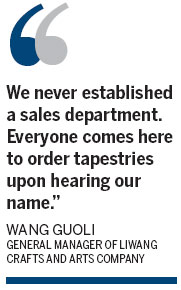
The art is booming in the factory today, but Chifeng's weaving business was not always this robust. According to Sun, who once worked in the city's largest among the 300 carpet factories, lack of creativity and dull color and style variations made the industry plummet in the 1990s.
"It is crucial to get closer to modern people's aesthetic standards," says Wang Guoli, the general manager of the factory. "The tapestries with unchanged themes on grasslands' sceneries and Mongolian ethnic group's daily life look fabulous in museums, but we must innovate and involve more elements to survive."
Wang, who once ran a factory making artistic bronze wares, began his weaving dream by establishing the workshop in 2000. Though he does not reveal the exact annual turnover, he says the expanding demand from the high-end market soon turned things around.
"We never established a sales department," he smiles. "Everyone comes here to order tapestries upon hearing our name."
Many fine works are even given to foreign leaders as "national gifts".
After attending fiber-arts exhibitions around the world, Wang is ready to expand overseas. He has an ambition to be established in Europe within five years.
"Europeans prefer abstract themes, so we have to make some adjustments. Having some artists create more original blueprints for us becomes a necessity," he says. "Nevertheless, these tapestries can be a good channel to let Chinese values become better known worldwide. We will mix in the Oriental philosophies, like tea culture and Zen."
And in the artisans' eyes, their works are not perfect yet.
"We are studying how to create the feeling of reliefs - to take designs that appear to be three-dimensional to the naked eye and weave real 3-D images," says Sun, the chief engineer. "The ways to explore for extremely delicate work will have no end."
Contact the writers through wangkaihao@chinadaily.com.cn.
(China Daily USA 09/05/2013 page8)
Most Viewed
Editor's Picks

|

|

|

|

|

|
Today's Top News
Why China dominates solar panels
Smithfield deal still in question
US faces substantial losses if Egypt aid halted
Bank of America finally exits CCB
S. Korea a model for innovation: experts
Xi, Putin meeting to focus on 'mega projects'
US divided over Syria attack
Ex-railway deputy chief pleads guilty
US Weekly

|

|
